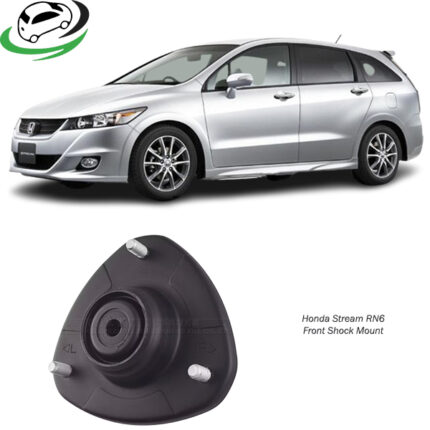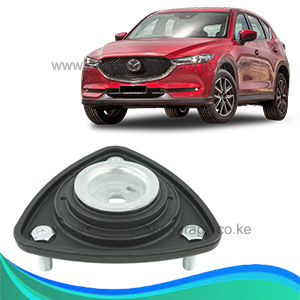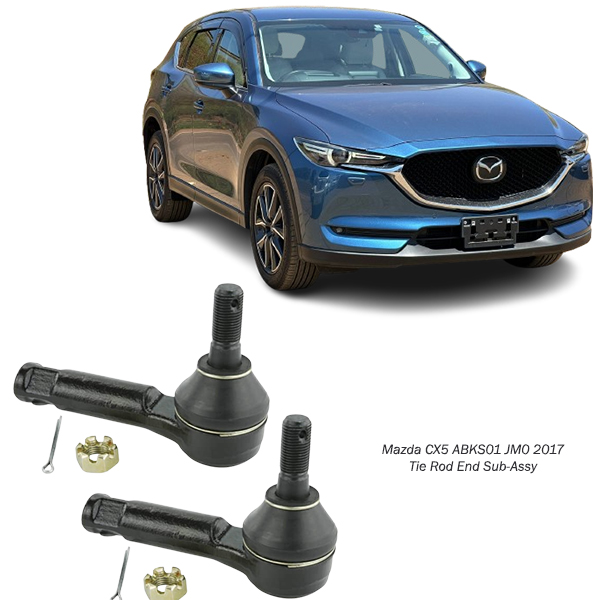-8%
Get Mazda CX-5 ABKS01 JM0 2017 Tie Rod End Sub-Assy KD31-32-280 in Kenya
The Tie Rod End Sub-Assembly is a key component in the steering system of most vehicles, providing the connection between the steering rack (or steering gear) and the steering knuckle, allowing for the precise control of a vehicle’s direction. Tie rod ends are critical for ensuring proper wheel alignment, steering response, and overall vehicle handling. This sub-assembly allows the vehicle’s steering system to accurately transfer the driver’s input, ensuring that the wheels turn smoothly and in response to steering efforts.
1. Basic Function of the Tie Rod End Sub-Assembly
The primary role of the tie rod end sub-assembly is to transfer steering input from the steering rack (or steering box) to the wheels of the vehicle. When the driver turns the steering wheel, the steering column sends the rotational motion down to the steering rack. The tie rods, in turn, transmit this motion to the steering knuckles, causing the wheels to pivot left or right.
Tie rod ends are important because they allow for this transmission of force while also accommodating the angular motion required for the wheels to turn. This is accomplished through the ball-and-socket design of the tie rod end, allowing for angular movement while maintaining the integrity of the steering linkage.
2. Components of the Tie Rod End Sub-Assembly
The tie rod end sub-assembly consists of several key parts, each performing a specific function to ensure the longevity and effectiveness of the steering system.
a. Tie Rod
The tie rod is a long, usually threaded component that connects the steering rack to the tie rod end. It is typically made from high-strength steel to withstand the forces encountered during steering. Tie rods can be found in two main configurations: inner and outer. The inner tie rod connects directly to the steering rack or gear, while the outer tie rod connects to the steering knuckle, which in turn is attached to the wheel assembly.
b. Tie Rod End (Ball Joint)
The tie rod end itself functions as a ball joint and is one of the most important parts of the sub-assembly. It connects the tie rod to the steering knuckle. The ball joint mechanism allows the steering knuckle to pivot smoothly as the wheels turn, while also providing a secure connection between the tie rod and knuckle. The tie rod end allows for the necessary range of motion while keeping the steering linkage intact.
c. Dust Boot
A dust boot (often made of rubber or synthetic material) is placed over the tie rod end to protect the ball joint from dirt, moisture, and debris. The dust boot helps prevent contaminants from entering the ball joint, which could cause premature wear and failure. It also ensures that the grease inside the joint stays intact for smoother operation.
d. Lock Nut
The lock nut is used to secure the tie rod end in place after the correct alignment has been achieved. This nut prevents the tie rod end from loosening during driving, ensuring the integrity of the steering linkage.
e. Grease Fitting
Some tie rod ends are equipped with a grease fitting to allow for the lubrication of the ball joint. Greasing the joint helps reduce friction, prolongs the life of the part, and ensures smooth movement during steering.
3. How the Tie Rod End Sub-Assembly Works
The tie rod end sub-assembly works by facilitating the motion of the steering system, converting the rotational movement of the steering wheel into linear motion that moves the wheels left or right. When the driver turns the steering wheel, the steering column turns the steering rack. The inner tie rod transfers this motion to the outer tie rod, which is connected to the steering knuckle by the tie rod end.
The tie rod end is designed to rotate, allowing the steering knuckle (and hence the wheels) to move. This motion must be precise to ensure the wheels turn accurately in response to steering input. The ball joint in the tie rod end allows the joint to move in multiple directions while keeping the steering system stable and the wheels responsive.
4. Types of Tie Rod Ends
There are several types of tie rod ends, each designed for specific steering systems and applications. The most common types include:
a. Conventional Tie Rod Ends
These are the most commonly used tie rod ends in modern vehicles, typically found in cars and light trucks with rack-and-pinion steering systems. They consist of a ball joint that allows angular movement, connected to the tie rod by a threaded sleeve.
b. Inner and Outer Tie Rod Ends
In vehicles with rack-and-pinion steering, the tie rod assembly typically includes an inner tie rod end that connects directly to the steering rack, and an outer tie rod end that connects to the steering knuckle. These are designed to be adjusted for proper alignment of the vehicle’s wheels.
c. Offset Tie Rod Ends
Offset tie rod ends are used in high-performance or modified vehicles where more precise steering geometry adjustments are needed. These ends have a design that allows for adjustments to the vehicle’s steering angles, improving handling and responsiveness, especially in sports or racing applications.
5. Importance of the Tie Rod End Sub-Assembly in Steering
The tie rod end sub-assembly plays a critical role in the vehicle’s overall steering performance. Here are some of the key ways it contributes to the vehicle’s handling:
a. Ensures Accurate Steering
Tie rod ends are vital for ensuring that the wheels respond accurately to steering input. When a tie rod end is functioning correctly, the driver can expect precise control over the vehicle’s direction, making steering predictable and reliable.
b. Helps Maintain Wheel Alignment
The tie rod end sub-assembly helps maintain proper alignment between the vehicle’s wheels. If the tie rods or tie rod ends are worn or damaged, it can lead to misalignment, causing issues like uneven tire wear, poor handling, and even unsafe driving conditions.
c. Provides Smooth Steering
Tie rod ends help to eliminate any play or slack in the steering system. By ensuring that the steering linkage is secure and responsive, tie rod ends contribute to smooth, stable steering. When tie rod ends wear out or fail, the vehicle may exhibit steering wheel play, reducing steering accuracy and stability.
6. Symptoms of Worn Tie Rod Ends
Over time, tie rod ends wear due to constant movement and exposure to road conditions. Worn tie rod ends can cause a variety of symptoms that indicate they need replacement. Common signs of worn or damaged tie rod ends include:
a. Steering Play
Excessive play in the steering wheel, where the wheel moves without a corresponding movement of the wheels, is often a sign of worn tie rod ends. This can result in poor steering responsiveness.
b. Uneven or Premature Tire Wear
If the tie rod ends are worn, it can cause the wheels to become misaligned, resulting in uneven or premature tire wear. You may notice that the tread on one side of the tire is more worn than the other.
c. Clunking or Popping Noises
When tie rod ends wear out, you may hear clunking or popping noises from the front of the vehicle when turning the steering wheel. These noises are caused by the movement of the ball joint inside the tie rod end.
d. Vibration in the Steering Wheel
A worn tie rod end can cause vibrations in the steering wheel, especially at higher speeds. This occurs because the steering linkage is no longer moving smoothly, leading to instability in the steering.
e. Pulling to One Side
If the tie rod ends are worn, it can cause the vehicle to pull to one side, making the steering feel unbalanced. This can be particularly dangerous when driving at high speeds or when braking.
7. Maintaining Tie Rod End Sub-Assembly
Regular maintenance of the tie rod end sub-assembly is crucial to ensure the longevity and safe operation of the steering system. Some of the maintenance practices include:
a. Regular Inspections
Tie rod ends should be inspected regularly, especially during routine wheel alignments, tire rotations, or brake checks. This will allow you to detect any signs of wear early and replace them before they cause steering problems.
b. Lubrication
Some tie rod ends have grease fittings that should be lubricated periodically to reduce friction and wear. Keeping the joints properly lubricated helps ensure smooth movement and reduces the risk of premature failure.
c. Wheel Alignment
After replacing tie rod ends, it’s important to perform a wheel alignment to ensure that the vehicle’s wheels are properly aligned. This helps prevent uneven tire wear and improves the vehicle’s handling.
8. Replacement of Tie Rod Ends
If you notice symptoms of worn tie rod ends, such as play in the steering wheel, clunking noises, or uneven tire wear, it’s important to replace the components as soon as possible. Replacing the tie rod ends typically involves:
- Lifting and securing the vehicle.
- Removing the old tie rod ends and tie rods.
- Installing the new components.
- Ensuring proper alignment and torque specifications.
- Performing a wheel alignment to ensure the vehicle’s alignment is restored.
Conclusion
The tie rod end sub-assembly is an essential component in the steering system of most vehicles, directly impacting steering precision, vehicle handling, and safety. Regular inspection and maintenance of tie rod ends are essential for the smooth operation of the steering system. Signs of wear such as steering play, uneven tire wear, or noise should be addressed immediately by replacing the damaged components. With proper care, the tie rod end sub-assembly will continue to perform reliably, ensuring optimal driving performance and safety.
Follow us on Facebook for more parts.



